Multi-Frequency Entropy for Quantifying Complex Dynamics and Its Application on EEG Data
Abstract
1. Introduction
2. Materials and Methods
2.1. Multivariate Entropy
2.1.1. Multivariate Permutation Entropy (mvPerEn)
2.1.2. Multivariate Sample Entropy (mvSampEn)
2.1.3. Multi-Frequency Entropy (mFreEn)
2.1.4. Algorithm Parameter Settings
2.2. Datasets and Data Preprocessing
2.2.1. Simulated Data Generated Using the MIX Model
2.2.2. Resting-State EEG
- (1)
- Parkinson’s disease dataset
- (2)
- Depressive tendency’s dataset
2.2.3. Task-State EEG
2.2.4. Data Preprocessing
2.2.5. Design and Analysis of Experiments
- (1)
- Analysis of simulated data
- (2)
- Analysis of real EEG data
3. Results
3.1. Evaluation of Algorithms Based on Simulated Data
3.1.1. The Sensitivity Analysis for White Gaussian Noise and 1/f Noise
3.1.2. Analysis of Amplitude Detection Capability Based on MIX Model
3.1.3. Analysis of Frequency Detection Capability Based on MIX Model
3.1.4. Noise Robustness Analysis
3.1.5. Effect of Data Length
3.2. Application of Algorithms Based on Real EEG Data
3.2.1. The Diagnosis of Brain Diseases
3.2.2. The Classification of Different Tasks
4. Discussion
- (1)
- Parameter settings for the mFreEn algorithm
- (2)
- The heightened sensitivity of mFreEn
- (3)
- The anti-noise performance of mFreEn
5. Limitations
6. Conclusions
Supplementary Materials
Author Contributions
Funding
Institutional Review Board Statement
Data Availability Statement
Conflicts of Interest
References
- Ahamed, S.I.; Rabbani, M.; Povinelli, R.J. A Comprehensive Survey on Detection of Non-linear Analysis Techniques for EEG Signal. In Proceedings of the IEEE International Conference on Digital Health (IEEE ICDH) at the IEEE World Congress on Services (SERVICES), Chicago, IL, USA, 2–8 July 2023; pp. 184–194. [Google Scholar]
- Rodriguez-Bermudez, G.; Garcia-Laencina, P.J. Analysis of EEG signals using nonlinear dynamics and chaos: A review. Appl. Math. Infom. Sci. 2015, 9, 2309. [Google Scholar]
- Falciano, F.T.; Peñafiel, M.L.; Bergliaffa, S.E.P. Entropy bounds and nonlinear electrodynamics. Phys. Rev. D 2019, 100, 125008. [Google Scholar] [CrossRef]
- Wątorek, M.; Tomczyk, W.; Gawłowska, M.; Golonka-Afek, N.; Żyrkowska, A.; Marona, M.; Wnuk, M.; Słowik, A.; Ochab, J.K.; Fafrowicz, M.; et al. Multifractal organization of EEG signals in multiple sclerosis. Biomed. Signal Process. 2024, 91, 105916. [Google Scholar] [CrossRef]
- Ji, G. Feature extraction method of ship-radiated noise based on dispersion entropy: A review. Front. Phys. 2023, 11, 1146493. [Google Scholar] [CrossRef]
- Jui, S.J.J.; Deo, R.C.; Barua, P.D.; Devi, A.; Soar, J.; Acharya, U.R. Application of Entropy for Automated Detection of Neurological Disorders With Electroencephalogram Signals: A Review of the Last Decade (2012–2022). IEEE Access 2023, 11, 71905–71924. [Google Scholar] [CrossRef]
- Tang, L.; Lv, H.; Yang, F.; Yu, L. Complexity testing techniques for time series data: A comprehensive literature review. Chaos Solitons Fractals 2015, 81, 117–135. [Google Scholar] [CrossRef]
- Averna, A.; Coelli, S.; Ferrara, R.; Cerutti, S.; Priori, A.; Bianchi, A.M. Entropy and fractal analysis of brain-related neurophysiological signals in Alzheimer’s and Parkinson’s disease. J. Neural Eng. 2023, 20, 051001. [Google Scholar] [CrossRef]
- Keshmiri, S. Entropy and the Brain: An Overview. Entropy 2020, 22, 917. [Google Scholar] [CrossRef]
- Rocha, P.L.; Barros, A.K.; Silva, W.S.; Sousa, G.C.; Sousa, P.; da Silva, A.M. Classification of the interictal state with hypsarrhythmia from Zika Virus Congenital Syndrome and of the ictal state from epilepsy in childhood without hypsarrhythmia in EEGs using entropy measures. Comput. Biol. Med. 2020, 126, 104014. [Google Scholar] [CrossRef]
- Dichio, V.; Fallani, F.D. Statistical models of complex brain networks: A maximum entropy approach. Rep. Prog. Phys. 2023, 86, 102601. [Google Scholar] [CrossRef]
- Bandt, C.; Pompe, B. Permutation entropy: A natural complexity measure for time series. Phys. Rev. Lett. 2002, 88, 174102. [Google Scholar] [CrossRef]
- Richman, J.S.; Moorman, J.R. Physiological time-series analysis using approximate entropy and sample entropy. Am. J. Physiol. Heart C 2000, 278, H2039–H2049. [Google Scholar] [CrossRef]
- Azami, H.; Escudero, J. Amplitude-aware permutation entropy: Illustration in spike detection and signal segmentation. Comput. Methods Programs Biomed. 2016, 128, 40–51. [Google Scholar] [CrossRef]
- Wu, S.D.; Wu, C.W.; Humeau-Heurtier, A. Applications, Refined scale-dependent permutation entropy to analyze systems complexity. Phys. A 2016, 450, 454–461. [Google Scholar] [CrossRef]
- Zheng, J.; Chen, Y.; Pan, H.; Tong, J. Composite multi-scale phase reverse permutation entropy and its application to fault diagnosis of rolling bearing. Nonlinear Dyn. 2023, 111, 459–479. [Google Scholar] [CrossRef]
- Wan, L.; Ling, G.; Guan, Z.H.; Fan, Q.J.; Tong, Y.H. Fractional multiscale phase permutation entropy for quantifying the complexity of nonlinear time series. Phys. A 2022, 600, 127506. [Google Scholar] [CrossRef]
- Bajic, D.; Japundzic-Zigon, N. On Quantization Errors in Approximate and Sample Entropy. Entropy 2022, 24, 73. [Google Scholar] [CrossRef]
- Lizama, L.E.C.; He, X.; Kalincik, T.; Galea, M.P.; Panisset, M.G. Sample Entropy Improves Assessment of Postural Control in Early-Stage Multiple Sclerosis. Sensors 2024, 24, 872. [Google Scholar] [CrossRef]
- Montesinos, L.; Castaldo, R.; Pecchia, L. On the use of approximate entropy and sample entropy with centre of pressure time-series. J. Neuroeng. Rehabil. 2018, 15, 116. [Google Scholar] [CrossRef]
- Fernández-Sotos, A.; Martínez-Rodrigo, A.; Moncho-Bogani, J.; Latorre, J.M.; Fernández-Caballero, A. Neural Correlates of Phrase Quadrature Perception in Harmonic Rhythm: An EEG Study Using a Brain-Computer Interface. Int. J. Neural Syst. 2018, 28, 1750054. [Google Scholar] [CrossRef]
- Morabito, F.C.; Labate, D.; La Foresta, F.; Bramanti, A.; Morabito, G.; Palamara, I. Multivariate Multi-Scale Permutation Entropy for Complexity Analysis of Alzheimer’s Disease EEG. Entropy 2012, 14, 1186–1202. [Google Scholar] [CrossRef]
- Ahmed, M.U.; Mandic, D.P. Multivariate multiscale entropy: A tool for complexity analysis of multichannel data. Phys. Rev. E 2011, 84, 061918. [Google Scholar] [CrossRef] [PubMed]
- Chen, J.; Zhou, D.; Lyu, C.; Lu, C. An integrated method based on CEEMD-SampEn and the correlation analysis algorithm for the fault diagnosis of a gearbox under different working conditions. Mech. Syst. Signal Process. 2018, 113, 102–111. [Google Scholar] [CrossRef]
- Zhou, F.; Han, J.; Yang, X. Multivariate hierarchical multiscale fluctuation dispersion entropy: Applications to fault diagnosis of rotating machinery. Appl. Acoust. 2021, 182, 108271. [Google Scholar] [CrossRef]
- Xi, C.; Yang, G.; Liu, L.; Jiang, H.; Chen, X. A Refined Composite Multivariate Multiscale Fluctuation Dispersion Entropy and Its Application to Multivariate Signal of Rotating Machinery. Entropy 2021, 23, 128. [Google Scholar] [CrossRef]
- Ma, D.; He, S.; Sun, K. A modified multivariable complexity measure algorithm and its application for identifying mental arithmetic task. Entropy 2021, 23, 931. [Google Scholar] [CrossRef]
- Zhang, Y.; Chen, X.; Pang, X.; Cheng, S.; Li, X.; Xie, P. Multiscale multivariate transfer entropy and application to functional corticocortical coupling. J. Neural Eng. 2021, 18, 046056. [Google Scholar] [CrossRef]
- Canolty, R.T.; Knight, R.T. The functional role of cross-frequency coupling. Trends Cogn. Sci. 2010, 14, 506–515. [Google Scholar] [CrossRef]
- Jensen, O.; Colgin, L.L. Cross-frequency coupling between neuronal oscillations. Trends Cogn. Sci. 2007, 11, 267–269. [Google Scholar] [CrossRef]
- Lin, A.J.; Liu, K.K.L.; Bartsch, R.P.; Ivanov, P.C. Dynamic network interactions among distinct brain rhythms as a hallmark of physiologic state and function. Commun. Biol. 2020, 3, 197. [Google Scholar]
- Dimitriadis, S.I.; Salis, C.I.; Liparas, D. An automatic sleep disorder detection based on EEG cross-frequency coupling and random forest model. J. Neural Eng. 2021, 18, 046064. [Google Scholar] [CrossRef] [PubMed]
- Jensen, O.; Mazaheri, A. Shaping functional architecture by oscillatory alpha activity: Gating by inhibition. Front. Hum. Neurosci. 2010, 4, 186. [Google Scholar] [CrossRef] [PubMed]
- Chen, B.; Ciria, L.F.; Hu, C.; Ivanov, P.C. Ensemble of coupling forms and networks among brain rhythms as function of states and cognition. Commun. Biol. 2022, 5, 82. [Google Scholar] [CrossRef] [PubMed]
- Manasova, D.; Stankovski, T. Neural Cross-Frequency Coupling Functions in Sleep. Neuroscience 2023, 52, 320–330. [Google Scholar] [CrossRef] [PubMed]
- Deng, B.; Cai, L.; Li, S.; Wang, R.; Yu, H.; Chen, Y.; Wang, J. Multivariate multi-scale weighted permutation entropy analysis of EEG complexity for Alzheimer’s disease. Cogn. Neurodynamics 2017, 11, 217–231. [Google Scholar] [CrossRef] [PubMed]
- Li, Y.; Meng, X.; Xiao, S.; Xu, F.; Lee, C.G. Multivariate variational mode decomposition and generalized composite multiscale permutation entropy for multichannel fault diagnosis of hoisting machinery system. Struct. Health Monit. 2024, 23, 1842–1874. [Google Scholar] [CrossRef]
- Mao, X.; Shang, P.; Li, Q. Multivariate multiscale complexity-entropy causality plane analysis for complex time series. Nonlinear Dynam. 2019, 96, 2449–2462. [Google Scholar] [CrossRef]
- Azami, H.; Smith, K.; Fernandez, A.; Escudero, J. Evaluation of resting-state magnetoencephalogram complexity in Alzheimer’s disease with multivariate multiscale permutation and sample entropies. In Proceedings of the 2015 37th Annual International Conference of the IEEE Engineering in Medicine and Biology Society (EMBC), Milan, Italy, 25–29 August 2015; pp. 7422–7425. [Google Scholar]
- Xiao, H.; Chanwimalueang, T.; Mandic, D.P. Multivariate multiscale cosine similarity entropy and its application to examine circularity properties in division algebras. Entropy 2022, 24, 1287. [Google Scholar] [CrossRef] [PubMed]
- Zheng, J.; Tu, D.; Pan, H.; Hu, X.; Liu, T.; Liu, Q. A refined composite multivariate multiscale fuzzy entropy and Laplacian score-based fault diagnosis method for rolling bearings. Entropy 2017, 19, 585. [Google Scholar] [CrossRef]
- Chen, S.; Shang, P.; Wu, Y. Multivariate multiscale fractional order weighted permutation entropy of nonlinear time series. Phys. A 2019, 515, 217–231. [Google Scholar] [CrossRef]
- Liu, H.; Zhang, X.; Zhang, X. Multiscale complexity analysis on airport air traffic flow volume time series. Phys. A 2020, 548, 124485. [Google Scholar] [CrossRef]
- Liu, J.; Lu, H.B.; Zhang, X.R.; Li, X.L.; Wang, L.; Yin, S.M.; Cui, D. Which Multivariate Multi-Scale Entropy Algorithm Is More Suitable for Analyzing the EEG Characteristics of Mild Cognitive Impairment? Entropy 2023, 25, 396. [Google Scholar] [CrossRef]
- Anjum, M.F.; Dasgupta, S.; Mudumbai, R.; Singh, A.; Cavanagh, J.F.; Narayanan, N.S. Linear predictive coding distinguishes spectral EEG features of Parkinson’s disease. Parkinsonism Relat. Disord. 2020, 79, 79–85. [Google Scholar] [CrossRef]
- Rostaghi, M.; Khatibi, M.M.; Ashory, M.R.; Azami, H. Fuzzy dispersion entropy: A nonlinear measure for signal analysis. IEEE Trans. Fuzzy Syst. 2021, 30, 3785–3796. [Google Scholar] [CrossRef]
- Li, Y.; Tang, B.; Jiao, S.; Zhou, Y. Optimized multivariate multiscale slope entropy for nonlinear dynamic analysis of mechanical signals. Chaos Soliton Fract. 2024, 179, 114436. [Google Scholar] [CrossRef]
- Zhao, C.; Sun, J.; Lin, S.; Peng, Y. Rolling mill bearings fault diagnosis based on improved multivariate variational mode decomposition and multivariate composite multiscale weighted permutation entropy. Measurement 2022, 195, 111190. [Google Scholar] [CrossRef]
- Aung, S.T.; Wongsawat, Y. Prediction of epileptic seizures based on multivariate multiscale modified-distribution entropy. PeerJ Comput. Sci. 2021, 7, e744. [Google Scholar] [CrossRef]
- Jomaa, M.E.S.H.; Van Bogaert, P.; Jrad, N.; Kadish, N.E.; Japaridze, N.; Siniatchkin, M.; Colominas, M.A.; Humeau-Heurtier, A. Multivariate improved weighted multiscale permutation entropy and its application on EEG data. Biomed. Signal Proces. 2019, 52, 420–428. [Google Scholar] [CrossRef]
- Azami, H.; Fernández, A.; Escudero, J. Multivariate multiscale dispersion entropy of biomedical times series. Entropy 2019, 21, 913. [Google Scholar] [CrossRef]
- Faes, L.; Nollo, G.; Porta, A. Information-based detection of nonlinear Granger causality in multivariate processes via a nonuniform embedding technique. Phys. Rev. E 2011, 83, 051112. [Google Scholar] [CrossRef] [PubMed]
- Gómez-García, J.A.; Godino-Llorente, J.I.; Castellanos-Dominguez, G. Non uniform Embedding based on Relevance Analysis with reduced computational complexity: Application to the detection of pathologies from biosignal recordings. Neurocomputing 2014, 132, 148–158. [Google Scholar] [CrossRef]
- Faes, L.; Nollo, G.; Porta, A. Non-uniform multivariate embedding to assess the information transfer in cardiovascular and cardiorespiratory variability series. Comput. Biol. Med. 2012, 42, 290–297. [Google Scholar] [CrossRef]
- Wang, X.; Si, S.; Li, Y. Variational embedding multiscale diversity entropy for fault diagnosis of large-scale machinery. IEEE Trans. Ind. Electron. 2021, 69, 3109–3119. [Google Scholar] [CrossRef]
- Porta, A.; Faes, L.; Nollo, G.; Bari, V.; Marchi, A.; De Maria, B.; Takahashi, A.C.; Catai, A.M. Conditional self-entropy and conditional joint transfer entropy in heart period variability during graded postural challenge. PLoS ONE 2015, 10, e0132851. [Google Scholar] [CrossRef]
- Xiao, H.; Mandic, D.P. Variational embedding multiscale sample entropy: A tool for complexity analysis of multichannel systems. Entropy 2021, 24, 26. [Google Scholar] [CrossRef]
- Li, W.J.; Shen, X.H.; Li, Y.; Chen, Z. Improved multivariate multiscale sample entropy and its application in multi-channel data. Chaos 2023, 331, 063125. [Google Scholar] [CrossRef]
- Porta, A.; Faes, L.; Bari, V.; Marchi, A.; Bassani, T.; Nollo, G.; Perseguini, N.M.; Milan, J.; Minatel, V.; Borghi-Silva, A. Effect of age on complexity and causality of the cardiovascular control: Comparison between model-based and model-free approaches. PLoS ONE 2014, 9, e89463. [Google Scholar] [CrossRef]
- Kohoutova, L.; Atlas, L.Y.; Buechel, C.; Buhle, J.T.; Geuter, S.; Jepma, M.; Koban, L.; Krishnan, A.; Lee, D.H.; Lee, S.; et al. Individual variability in brain representations of pain. Nat. Neurosci. 2022, 25, 749. [Google Scholar] [CrossRef]
- Rashid, B.; Calhoun, V. Towards a brain-based predictome of mental illness. Hum. Brain Mapp. 2020, 41, 3468–3535. [Google Scholar] [CrossRef]
- Ansari, L.; Ji, S.; Chen, Q.; Cambria, E. Ensemble Hybrid Learning Methods for Automated Depression Detection. IEEE Trans. Comput. Soc. Syst. 2023, 10, 211–219. [Google Scholar] [CrossRef]
- Turner, W.; Blom, T.; Hogendoorn, H. Visual Information Is Predictively Encoded in Occipital Alpha/Low-Beta Oscillations. J. Neurosci. 2023, 43, 5537–5545. [Google Scholar] [CrossRef] [PubMed]
- Rupp, K.; Roos, M.; Milsap, G.; Caceres, C.; Ratto, C.; Chevillet, M.; Crone, N.E.; Wolmetz, M. Semantic attributes are encoded in human electrocorticographic signals during visual object recognition. Neuroimage 2017, 148, 318–329. [Google Scholar] [CrossRef] [PubMed]
- He, S.; Sun, K.; Wang, H. Multivariate permutation entropy and its application for complexity analysis of chaotic systems. Phys. A 2016, 461, 812–823. [Google Scholar] [CrossRef]
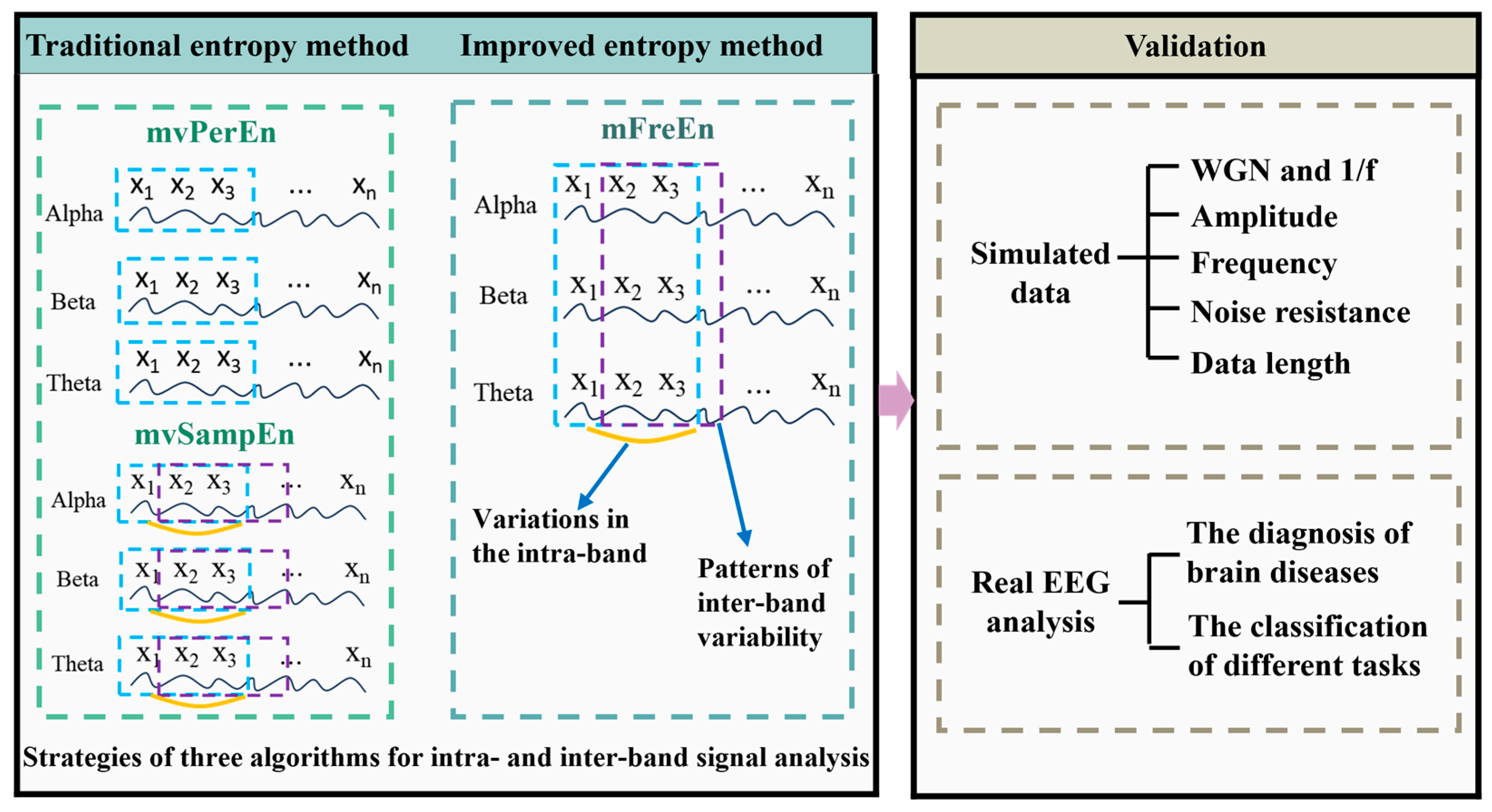

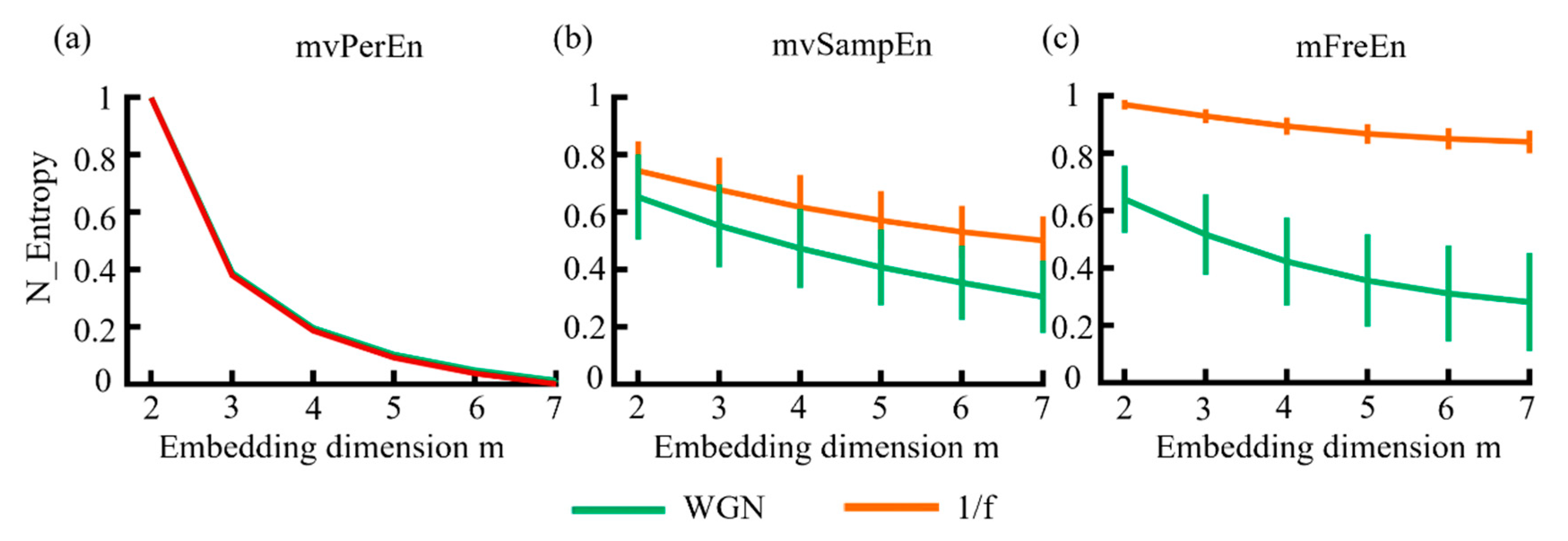
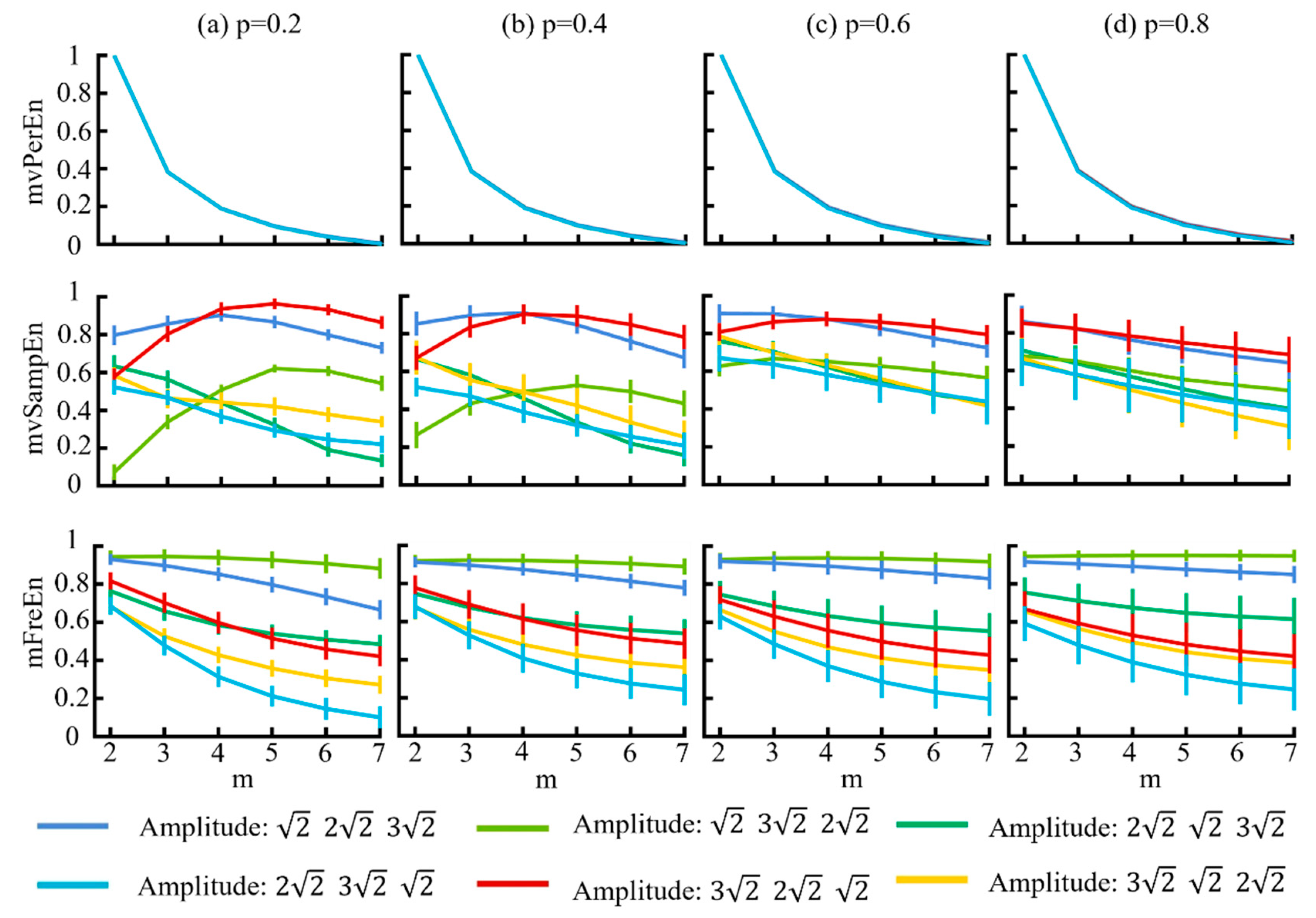
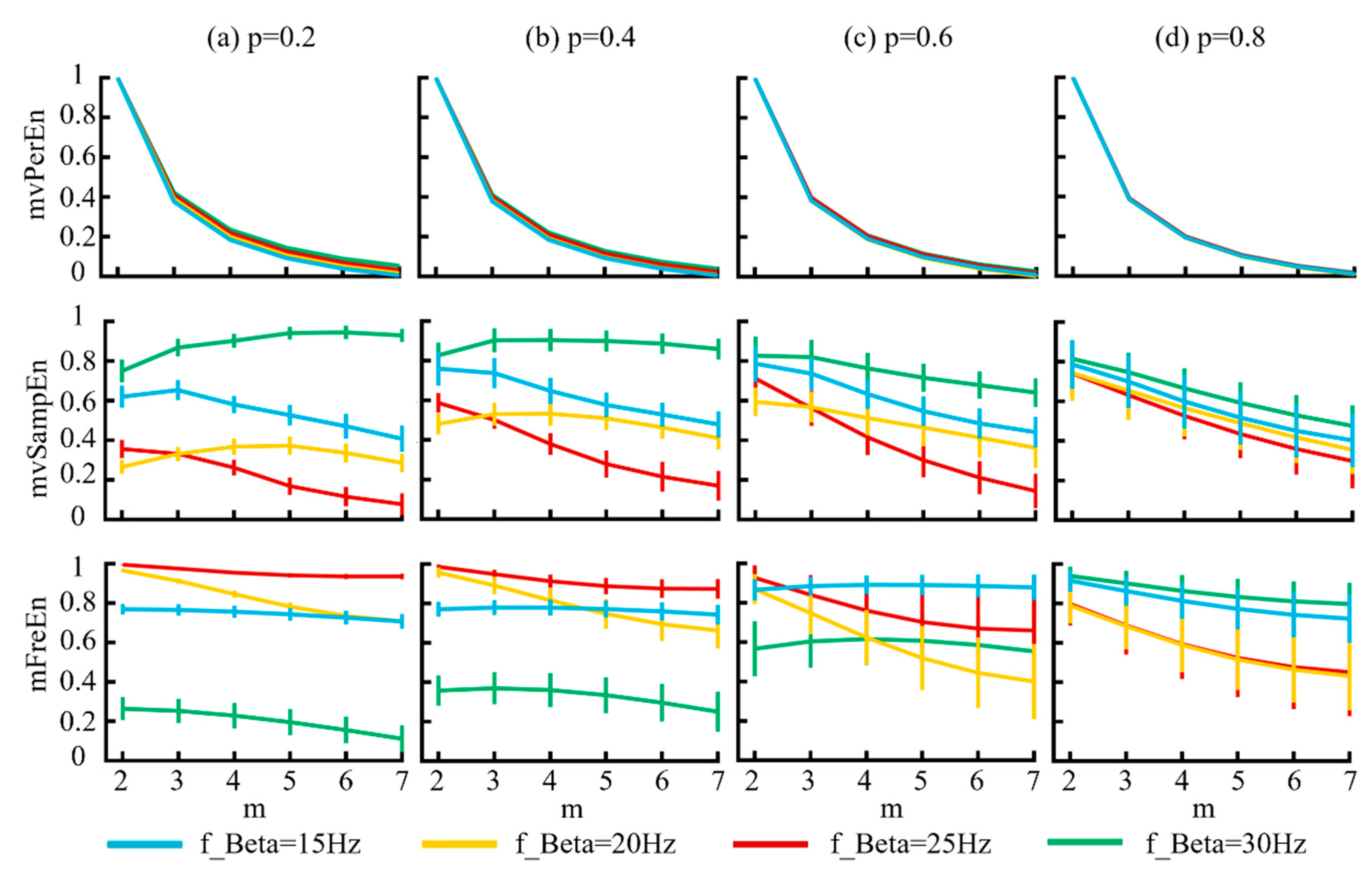
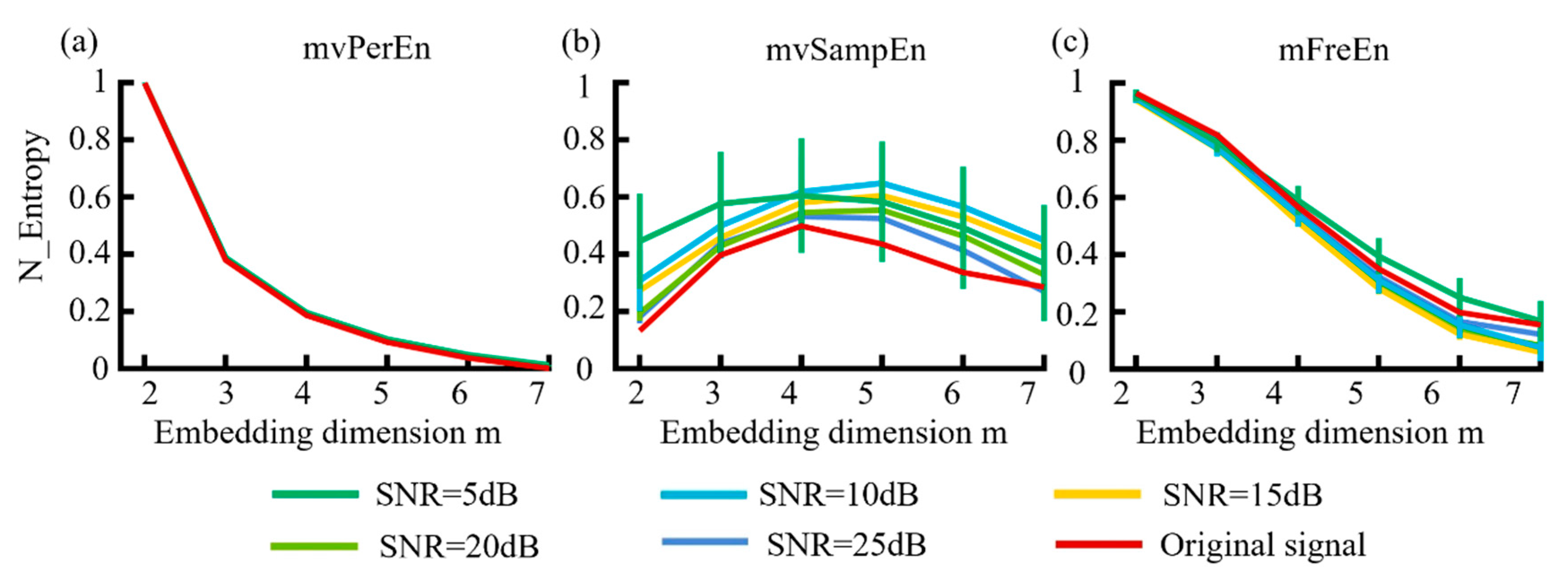
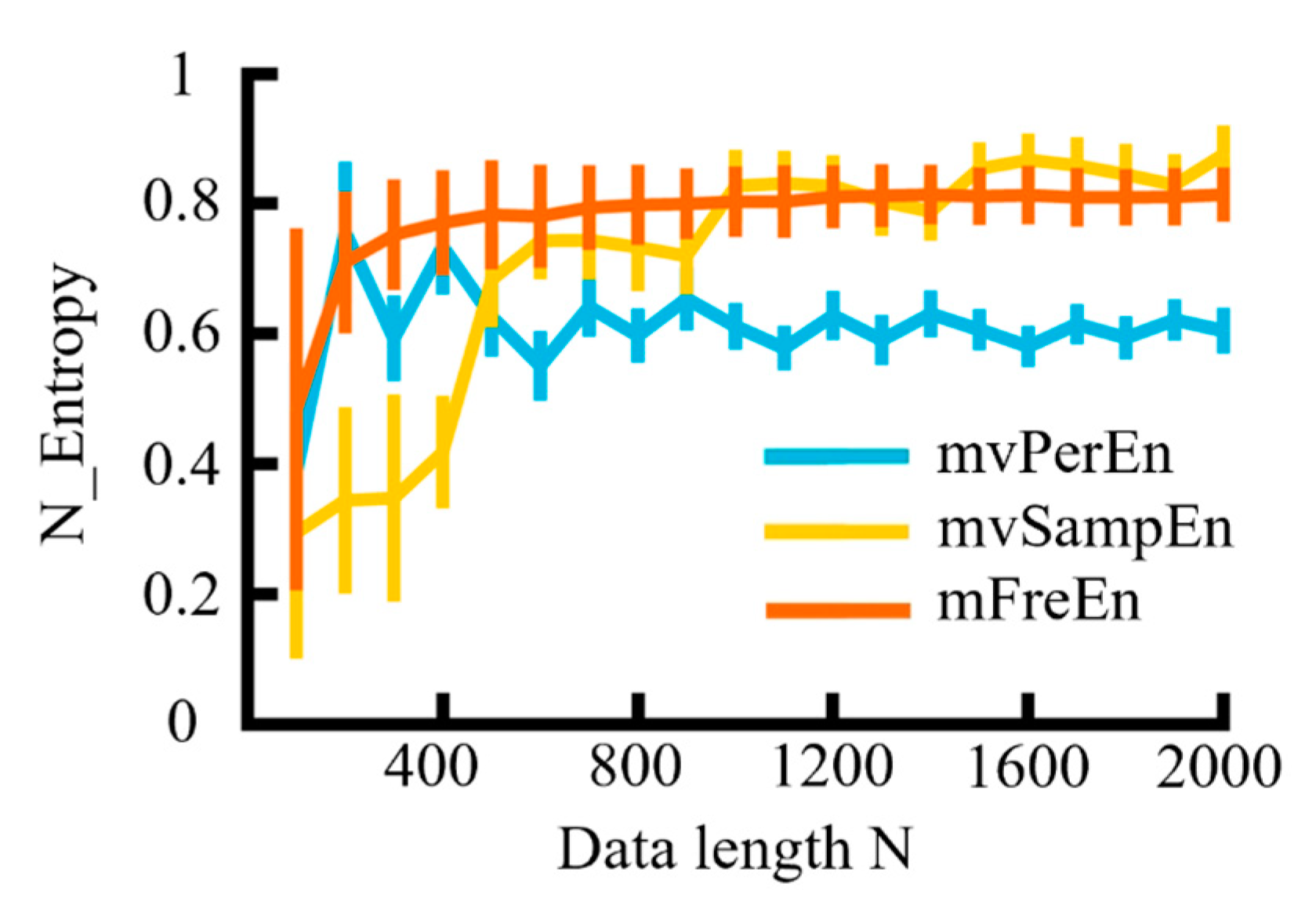


Disclaimer/Publisher’s Note: The statements, opinions and data contained in all publications are solely those of the individual author(s) and contributor(s) and not of MDPI and/or the editor(s). MDPI and/or the editor(s) disclaim responsibility for any injury to people or property resulting from any ideas, methods, instructions or products referred to in the content. |
© 2024 by the authors. Licensee MDPI, Basel, Switzerland. This article is an open access article distributed under the terms and conditions of the Creative Commons Attribution (CC BY) license (https://creativecommons.org/licenses/by/4.0/).
Share and Cite
Niu, Y.; Xiang, J.; Gao, K.; Wu, J.; Sun, J.; Wang, B.; Ding, R.; Dou, M.; Wen, X.; Cui, X.; et al. Multi-Frequency Entropy for Quantifying Complex Dynamics and Its Application on EEG Data. Entropy 2024, 26, 728. https://doi.org/10.3390/e26090728
Niu Y, Xiang J, Gao K, Wu J, Sun J, Wang B, Ding R, Dou M, Wen X, Cui X, et al. Multi-Frequency Entropy for Quantifying Complex Dynamics and Its Application on EEG Data. Entropy. 2024; 26(9):728. https://doi.org/10.3390/e26090728
Chicago/Turabian StyleNiu, Yan, Jie Xiang, Kai Gao, Jinglong Wu, Jie Sun, Bin Wang, Runan Ding, Mingliang Dou, Xin Wen, Xiaohong Cui, and et al. 2024. "Multi-Frequency Entropy for Quantifying Complex Dynamics and Its Application on EEG Data" Entropy 26, no. 9: 728. https://doi.org/10.3390/e26090728
APA StyleNiu, Y., Xiang, J., Gao, K., Wu, J., Sun, J., Wang, B., Ding, R., Dou, M., Wen, X., Cui, X., & Zhou, M. (2024). Multi-Frequency Entropy for Quantifying Complex Dynamics and Its Application on EEG Data. Entropy, 26(9), 728. https://doi.org/10.3390/e26090728






